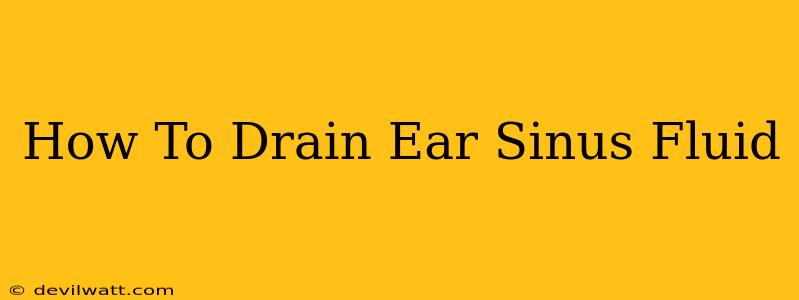Sinus and ear infections are incredibly uncomfortable, often causing a build-up of fluid that leads to pain, pressure, and hearing difficulties. While medical attention is crucial for persistent or severe symptoms, understanding how to potentially alleviate some of the discomfort at home can be beneficial. This guide explores safe and effective methods to help drain ear and sinus fluid, emphasizing when professional help is absolutely necessary.
Understanding Ear and Sinus Fluid Buildup
Before diving into solutions, it's vital to understand why fluid accumulates in your ears and sinuses. This often stems from infections (viral, bacterial, or fungal), allergies, or inflammation. The fluid can be thick and mucus-like, leading to a plugged-up feeling and reduced hearing acuity. The interconnectedness of the sinuses and Eustachian tubes (which connect the middle ear to the back of the throat) means that problems in one area can easily affect the other.
Common Symptoms of Ear and Sinus Fluid Buildup:
- Ear pain or pressure: A dull ache or sharp pain in the ear.
- Fullness or blockage in the ear: Feeling like your ear is plugged.
- Hearing loss: Temporary or intermittent decrease in hearing.
- Ringing in the ears (tinnitus): A buzzing or ringing sensation.
- Sinus pain and pressure: Pain or pressure in the forehead, cheeks, or around the eyes.
- Facial pain: Pain in the face, often near the sinuses.
- Postnasal drip: Mucus dripping down the back of the throat.
- Headache: Often associated with sinus pressure.
- Fever: May indicate an infection.
- Cough: Can be caused by postnasal drip.
Safe and Effective Home Remedies
Disclaimer: These home remedies may provide temporary relief but are not a replacement for professional medical advice. If your symptoms are severe or persistent, consult a doctor immediately.
1. Saline Nasal Rinse (Neti Pot):**
A saline rinse helps clear nasal passages, potentially improving drainage and reducing sinus pressure. Use distilled or sterile water to prepare the solution. Follow the instructions carefully to avoid introducing bacteria. Proper technique is essential to prevent infection.
2. Warm Compresses:**
Applying a warm compress to the affected ear or sinuses can help soothe pain and promote drainage. Use a clean, warm (not hot!) washcloth or towel.
3. Hydration:**
Drinking plenty of fluids, especially water, helps thin the mucus, making it easier to drain.
4. Humidifier:**
Using a humidifier adds moisture to the air, which can help loosen congested mucus.
5. Elevating Your Head:**
Sleeping with your head elevated can help improve drainage. Use extra pillows to keep your head above your chest.
6. Over-the-Counter Medications:**
Over-the-counter pain relievers like ibuprofen or acetaminophen can help reduce pain and fever. Decongestants can temporarily relieve congestion, but should be used cautiously and not for prolonged periods.
When to Seek Medical Attention
It's crucial to seek professional medical help if:
- Your symptoms are severe or worsen.
- You have a high fever.
- You experience hearing loss that doesn't improve.
- You have persistent ear pain or pressure.
- You have signs of a serious infection.
- Home remedies don't provide relief.
Your doctor may recommend:
- Nasal corticosteroids: To reduce inflammation.
- Antibiotics: If a bacterial infection is present.
- Antiviral medications: If a viral infection is suspected.
- Eustachian tube drainage: In certain cases of middle ear fluid buildup.
Ear and sinus fluid buildup can be a frustrating and painful experience. While home remedies can offer temporary relief, it's important to remember that they are not a cure. Always prioritize consulting a healthcare professional for proper diagnosis and treatment, especially if your symptoms are severe or persistent.

